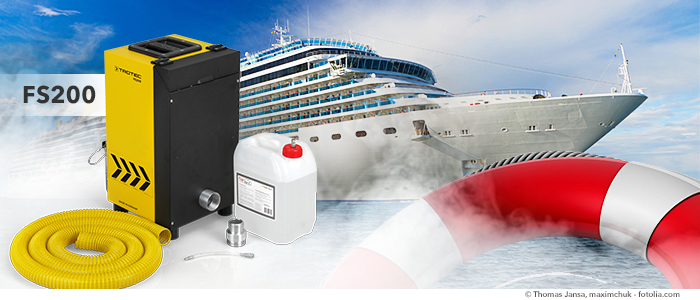“Everyone on deck!” and “Women and children first!”: Cries that we have all heard in films when a boat gets into trouble. Though it sounds dramatic, things are not quite so short and sharp when there is a fire on a passenger vessel. There are all sorts of rules which need to be observed when there is an emergency on the high seas. So the ship’s crew members need to be very well trained. When an evacuation drill is being held, staff in particular need to act quickly and with authority in order to get passengers to safety. How this works in smoke-filled areas on a boat is best experienced realistically. This is why smoke machines are used – for example Trotec’s FS200 fog and flue gas simulator.
Even though modern technology makes travelling on the high seas extremely safe, crew and passengers alike need to be told exactly what to do in case of emergency at the beginning of a voyage. This is because a fire on a passenger vessel is just about the worst thing that can happen. After all, there is nowhere to run to, so evacuation by lifeboat is the only option. And smoke is the main danger for people in this situation. Because narrow passageways, numerous flights of stairs, ventilation shafts and the air conditioning system are all factors which can make toxic fumes spread at lightning speed throughout the ship. The enormous heat given off is another massive problem. The temperatures generated when there is a fire on board a ship can burn holes even in steel walls.
First of all, the passengers and crew need to be taken to safety, in other words, up on deck where there is fresh air. So that people react calmly, take the proper security measures and follow the crew’s instructions with as cool a head as possible, a muster drill is held at the start of any sea cruise. All passengers have to take part in this drill. International regulations agreed under the aegis of the United Nations also stipulate that the ship’s crew have to undergo additional training to deal with an evacuation.
In this context, it is important for the crew that the emergency is tested under realistic conditions. An evacuation drill in smoke-filled rooms should be standard. As this is the only way in which crew members can learn how they have to act if smoke spreads at great speed below deck. The narrow passageways very quickly fill with smoke so that visibility is reduced to less than 30 centimetres.
Thick smoke build-ups
Trotec’s FS200 fog and flue gas simulator is ideal for this type of drill. The powerful fan turbine and the infinitely variable fluid pump can produce white smoke in seconds. So the area concerned can be filled with fog – completely harmless, of course – in minutes. The visibility levels will be similar to those experienced when there is a fire below deck.
The FS200 can be set up anywhere for this type of drill. And in no time at all! Being compact and light, the unit can easily be carried around and plugged in. Combining the output of the turbine, heater and pump guarantees a thick flow of smoke that remains consistent for several minutes, without needing to be heated up again. So the crew can give the drill their full concentration, and prepare for the emergency with no interruptions.


